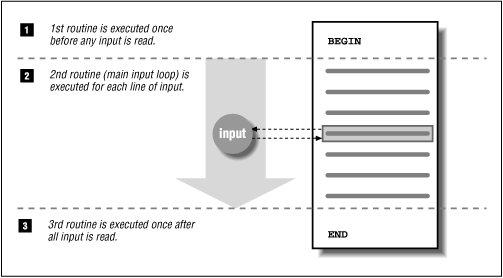 | Chapter 7 Writing Scripts for awk |  |
It's important to understand the basic model that awk offers the programmer. Part of the reason why awk is easier to learn than many programming languages is that it offers such a well-defined and useful model to the programmer.
An awk program consists of what we will call a main input loop. A loop is a routine that is executed over and over again until some condition exists that terminates it. You don't write this loop, it is given - it exists as the framework within which the code that you do write will be executed. The main input loop in awk is a routine that reads one line of input from a file and makes it available for processing. The actions you write to do the processing assume that there is a line of input available. In another programming language, you would have to create the main input loop as part of your program. It would have to open the input file and read one line at a time. This is not necessarily a lot of work, but it illustrates a basic awk shortcut that makes it easier for you to write your program.
The main input loop is executed as many times as there are lines of input. As you saw in the "Hello, world" examples, this loop does not execute until there is a line of input. It terminates when there is no more input to be read.
Awk allows you to write two special routines that can be executed before any input is read and after all input is read. These are the procedures associated with the BEGIN and END rules, respectively. In other words, you can do some preprocessing before the main input loop is ever executed and you can do some postprocessing after the main input loop has terminated. The BEGIN and END procedures are optional.
You can think of an awk script as having potentially three major parts: what happens before, what happens during, and what happens after processing the input. Figure 7.1 shows the relationship of these parts in the flow of control of an awk script.

Of these three parts, the main input loop or "what happens during processing" is where most of the work gets done. Inside the main input loop, your instructions are written as a series of pattern/action procedures. A pattern is a rule for testing the input line to determine whether or not the action should be applied to it. The actions, as we shall see, can be quite complex, consisting of statements, functions, and expressions.
The main thing to remember is that each pattern/action procedure sits in the main input loop, which takes care of reading the input line. The procedures that you write will be applied to each input line, one line at a time.